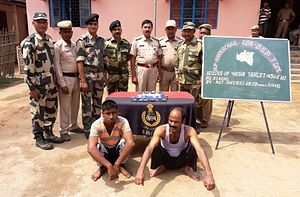On April 5, Lt. Col. Ahmed Yousuf Jamil told the media in Bangladesh that seized consignments of a drug called yaba at Sylhet originated in Myanmar and were transported through India. His statement comes after a series of intermittent seizures in India of yaba tablets that were meant for Bangladesh, indicating the existence of multiple exit points along the border in the Indian states of Tripura, Assam, and Meghalaya.
Yaba, a brightly colored tablet, is a cocktail of methamphetamine and caffeine. Its origins are traced to Japan when a chemist named Akira Ogata first manufactured it in 1918. In Myanmar, most of the yaba production labs are in Shan state along the border with China, which is controlled by the United Wa State Army (UWSA), a rebel group that had inked a ceasefire agreement with the Myanmar military (Tatmadaw) in 1989. Inputs suggest that some labs have surfaced at other places in the country including the disturbed Rakhine state and Sagaing Division, where a similar item called the “World Is Yours” is also produced.
India’s Northeast shares a long border of 1,880 kilometers with Bangladesh, which passes through a bewildering range of hills, plains, and rivers, making the task of policing it fully extremely challenging on both the sides. Efforts are on by the Indian government to expedite the fencing of the border, but there are too many gaps that make the task for the traffickers easier. All these issues, including drug trafficking, have figured prominently in the meetings between the Border Security Force (India) and Border Guards Bangladesh.
Two Routes in India’s Northeast
Consignments confiscated in the last three years reveal that two routes are active in India’s Northeast that transport the synthetic drug from Myanmar to Bangladesh. More prolific is the route through Mizoram originating at Champhai, which leads to different locations on the India-Bangladesh border.
“Champhai is very well connected to cities in Myanmar that include Tiddim and Mandalay. The possibility of these drugs landing in Bangladesh cannot be ruled out,” said superintendent of police T. Sailo. He revealed details about a seizure last year in the district ahead of the assembly polls, which yielded yaba pills worth about $160 million.
The other route passes through Manipur, which is contiguous to Myanmar’s Sagaing Division.
The reason for more drugs flowing into these channels is the crackdown in Bangladesh, resulting in the disruption of some networks that linked the country to Myanmar. Since the operation began last year, more than 200 drug dealers have been killed in encounters with the authorities, about 25,000 apprehended, and over a hundred “Yaba Godfathers” have been forced to surrender in Bangladesh.
However, despite all the efforts to curb drug trafficking, not all the arteries from Myanmar have been choked. Several routes are still active in the coastal district of Bangladesh’s Cox’s Bazar, which is also home to tens of thousands of Rohingya refugees.
Who Runs the Network?
Some Indian government officials are of the view that yaba is carried through routes that are also used for ferrying other contraband items. “It has been noticed on several occasions that the same gangs are involved in smuggling different commodities. For instance, the networks facilitating the import of gold and heroin from Myanmar are also being used for yaba and World Is Yours,” said an official speaking on condition of anonymity.
The pattern so far in the supply chain indicates that a large number of gangs are engaged, whose roles are clearly defined in the illicit trade. The consignments are received by different groups of traffickers near the India-Myanmar border, which are subsequently dispatched to far-off destinations through agents at select locations who would not know the source of the item.
On March 28 last year, two traffickers arrested with yaba tablets at Mankachar in the Indian state of Assam disclosed that they had received the packets in neighboring Meghalaya on “credit” from a local dealer but they were unaware of the source of the consignment. If a route is busted, the hunt begins immediately for a safer one that would continue transporting the pills to Bangladesh. There is no dearth of traffickers given the low income and impoverished conditions of inhabitants along the India-Bangladesh border.
Yaba is only one commodity on the long list of contraband items exported from India’s Northeast to Bangladesh. A banned cough syrup in India called Phensedyl produced in laboratories in some northern states of the country is just as popular in Bangladesh, which supposedly gives more profits to the traffickers. There are also reports suggesting the emergence of manufacturing units in the Northeast and north Bengal. Trucks carrying the item in large quantities have been seized by the police near the border on many occasions.
Rajeev Bhattacharyya is a senior journalist in Assam, India.

































